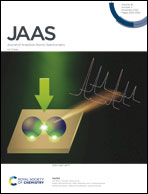Revealing hidden features of a Japanese articulated iron lobster via non-destructive local elemental analysis and 3D imaging†
Abstract
We present a workflow to non-destructively determine the elemental compositions of internal volumes of interest enclosed within complex-shaped objects, by combining 3D X-ray or neutron imaging, prompt-gamma activation analysis, and advanced Monte Carlo computer simulations. The correction of neutron- and gamma-attenuation effects during elemental analysis made it possible for the first time to obtain quantitative elemental compositions for such geometries. We applied the method successfully to an articulated iron lobster artifact from Japan’s Edo period. Using synchrotron X-ray and neutron imaging, we revealed that it has been constructed from numerous hammered plates. Rivets and two kinds of solder materials were identified based on the contrasts observed in the XCT images; these were selected for local composition analysis. It was found that one soldering material consisted of Cu63Zn37 brass, while the other was composed of a eutectic tin and lead alloy Sn39Pb61. The Zn/Cu adhesive is widely used to bond small areas, whereas the Sn/Pb adhesive is used for attaching larger surfaces.



 Please wait while we load your content...
Please wait while we load your content...